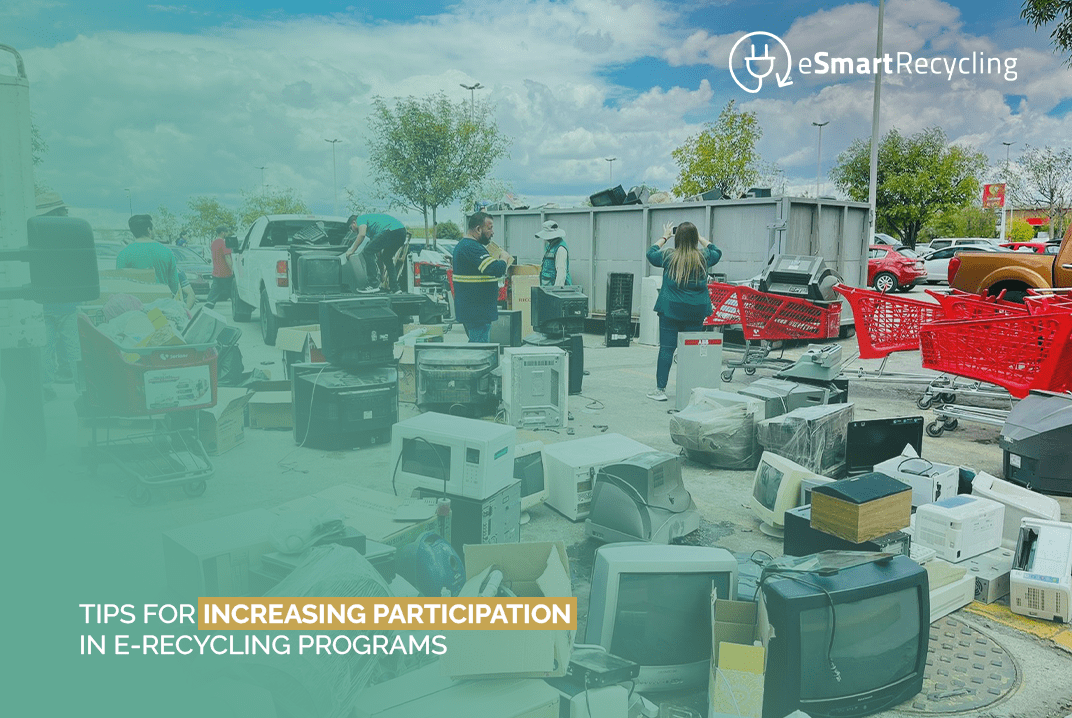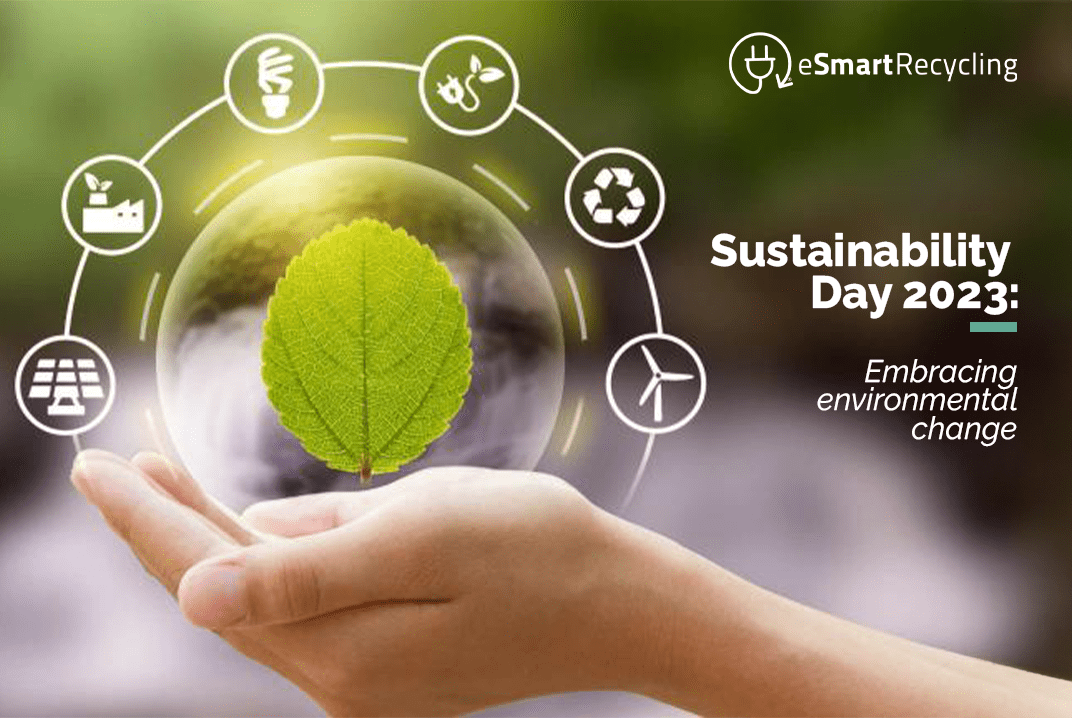
eSmart
Recycling
Securely manage and recycle technology to sustainably maximize and measure social impact.
#eSmartWay

What best describes you?
Business / Institutional
IT Asset Management and Disposition Services that fit your needs.
Nonprofits
A sustainable source of refurbished computers for the kids and families you serve
Residential
Recycle your old electronics, and join the E-Revolution
Discover the
eSmart way
It's always a win-win-win
and let’s create one together.







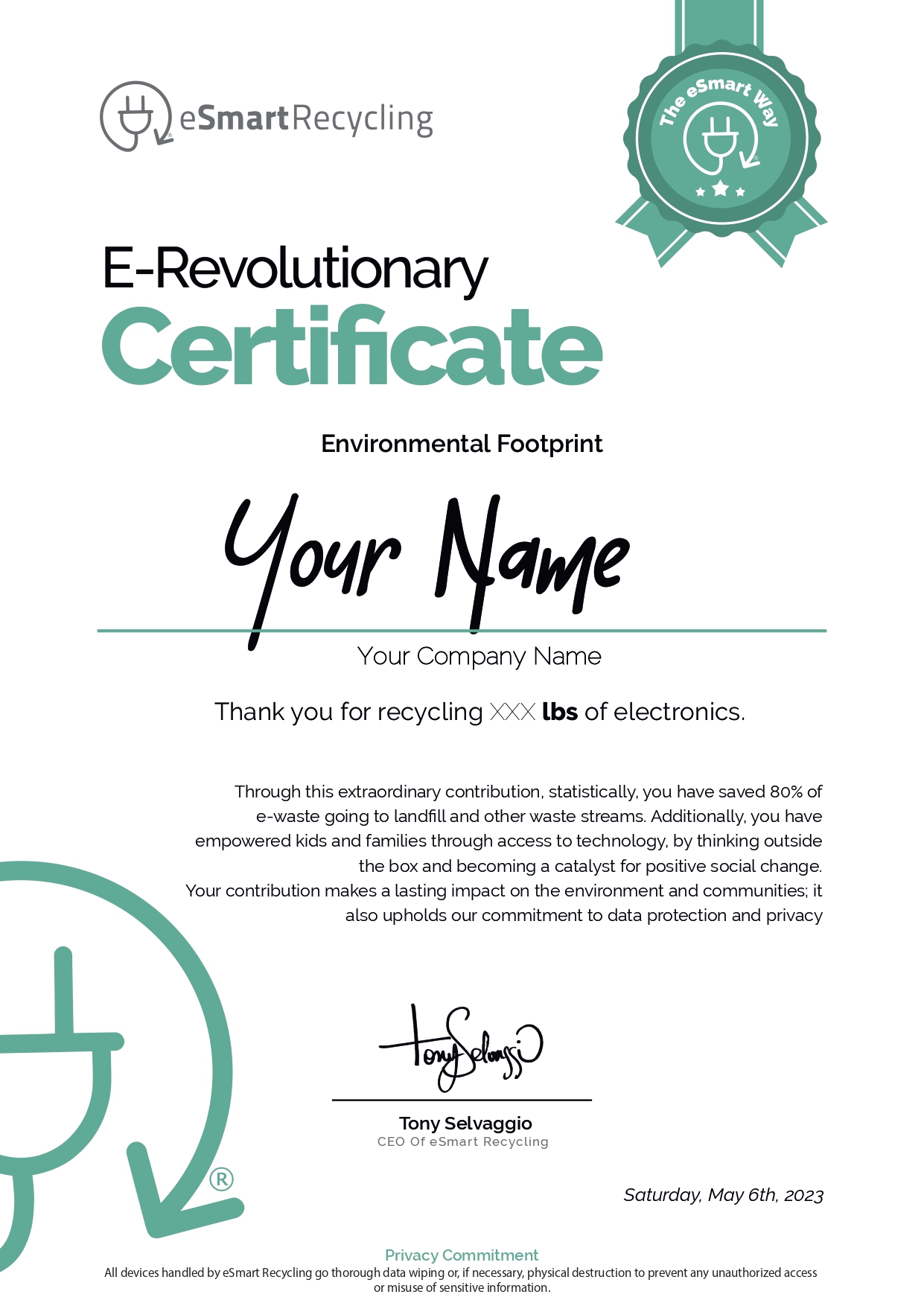
Measure and showcase
your environmental and social impact
Keep track of the efforts in real-time through your partner portal.
Do you need customized reporting for your ESG requirements? We create bespoke plans to fit your needs.
Highest complience standarts
for data security and recycling
Your data security is one of our biggest priorities. We are 100% committed to protecting your personal and business information, IT assets, and business interests.
At eSmart Recycling, we understand our customers need to focus on what they do best, and that’s why they rely on us to get the job done, right. We provide a transparent full chain of custody as we manage the process of recycling, reuse, recovery, and retirement of electronic material at the highest compliance standards.
For more information about standards, certificates and compliance requirements, please contact us directly.
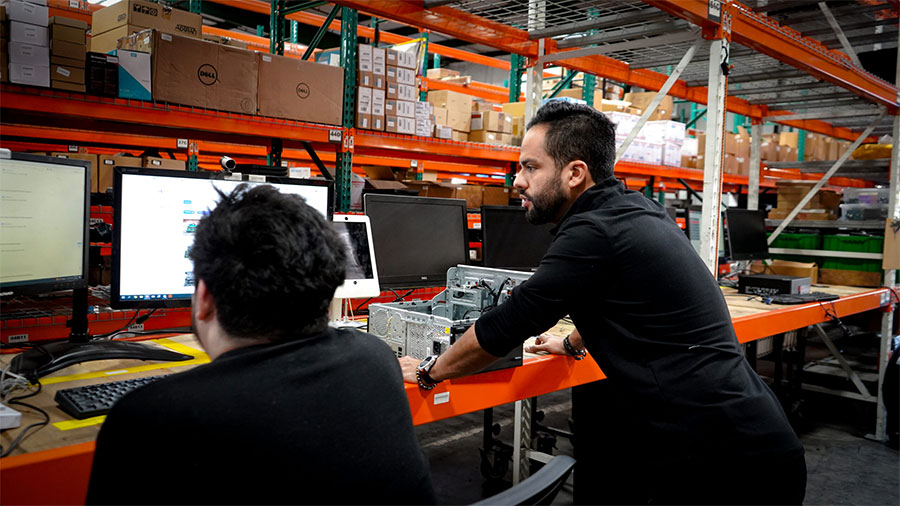
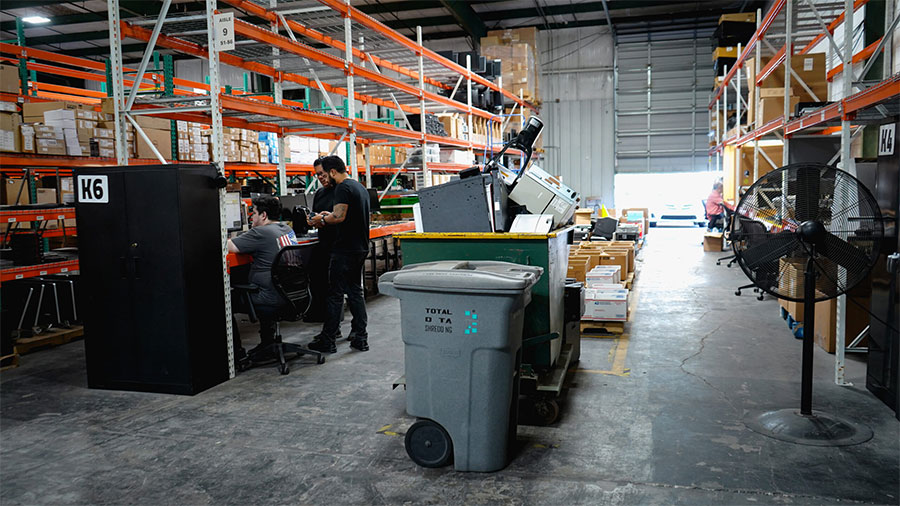
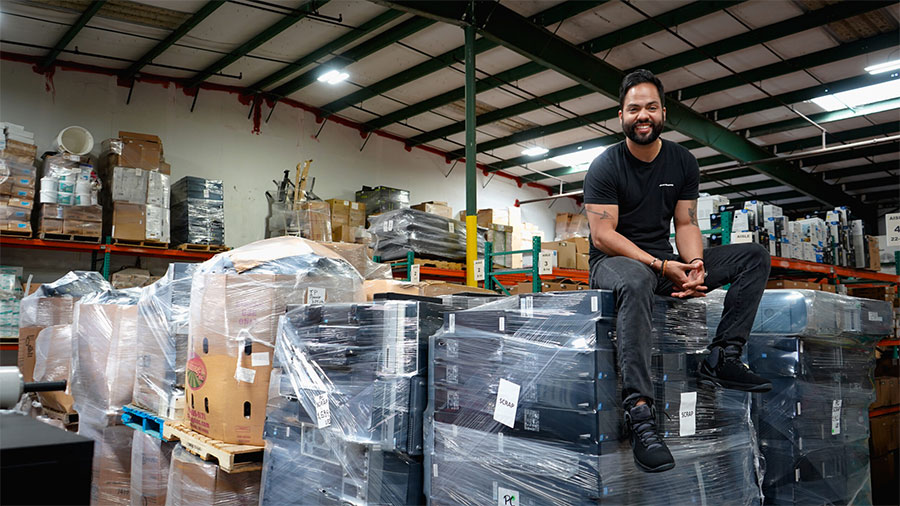


How does the
process work
1.
Equipment Collection: We take care of all the logistics.
2.
Audit and Inventory: Our robust inventory process takes account of every piece of equipment we collect, and we report it back to you.
3.
Data Destruction: We are your last line of defense. Here is when we remove hard drives and other data or media-containing devices and destroy them.
4.
Assessment: Here's where we find the best ways we have to monetize and generate impact with the material that was picked up.
5.
Partner Report: You'll receive access to your partner portal, where you will see exactly all documentation from each pick-up, such as your audit report, and certificate of data destruction. You will know your environmental footprint.
6.
Deployments and social impact: About 20% of our proceeds go towards funding computers for kids and families worldwide who don't have access to technology in partnership with the Digital Education Foundation.
Featured in:
![logos2[1]-04](https://esmartrecycling.com/wp-content/uploads/2023/09/logos21-04.png)
![logos2[1]-07](https://esmartrecycling.com/wp-content/uploads/2023/09/logos21-07.png)
![logos2[1]-08](https://esmartrecycling.com/wp-content/uploads/2023/09/logos21-08.png)
![logos2[1]-09](https://esmartrecycling.com/wp-content/uploads/2023/09/logos21-09.png)
![logos2[1]-10](https://esmartrecycling.com/wp-content/uploads/2023/09/logos21-10.png)
![logos2[1]-12](https://esmartrecycling.com/wp-content/uploads/2023/09/logos21-12.png)
![logos2[1]-13](https://esmartrecycling.com/wp-content/uploads/2023/09/logos21-13.png)
![logos2[1]-14](https://esmartrecycling.com/wp-content/uploads/2023/09/logos21-14.png)
![logos2[1]-18](https://esmartrecycling.com/wp-content/uploads/2023/09/logos21-18.png)
![logos2[1]-11](https://esmartrecycling.com/wp-content/uploads/2023/09/logos21-11.png)



+ 10,000
Kids and families now have access to technology because of our joint efforts
+ 10,000
Kids and families now have access to technology because of our joint efforts
+ 10,000
Kids and families
now have access to technology
because of our joint efforts
Join us in making the world a better place
As we continue to evolve, we are understanding that equality of opportunities across the board must be a priority on everyone’s agenda. Humanity’s biggest threat right now is the lack of sustainable access to basic human rights, such as education, and technology. It is our responsibility to lead by example, to think outside the box, and to work together to solve the problems our community is facing. It starts with an old computer. Are you ready to join the E-Revolution?

Tony Selvaggio, CEO

Our team
Awesome people great results
Together we can make a difference, and our team is the driving force that turns ideas into reality.


Walter
Test Bench Specialist


Fernando
Packing Specialist.


Ronald
Route Specialist


Luis
Warehouse Manager


Antonio
e-Commerce Sales Specialist


Jose
SEO & Community Manager
We take action
Because we care
Adults will have had no education beyond primary school by 2030 – Gordon Brown.
about 80% of electronics end up in a landfill and contaminate the earth, according to the E.P.A.
Of our proceeds are used to fund the refurbishment of computers and deploy them through our amazing distribution partners.
A single computer we deploy through our programs reaches 4 people on average.

Our blog
Recent News & articles
Stay up to date on what we are doing in the community along with our partners, and other relevant information in the world of technology, and sustainability.
July 23, 2024
More and more companies are starting to implement electronic device recycling programs to reduce their environmental impact and meet their sustainability goals. However, getting employees to participate in e-recycling programs can be quite challenging. In this article, we’ll discuss some strategies to increase employee participation in electronic recycling programs within companies.
Inform employees about the benefits of electronic recycling
The first step to increasing employee participation in e-recycling programs is ensuring that all employees understand the benefits of recycling electronic devices. Recycling is not only good for the environment, but it can also help companies save money, reduce their carbon footprint, and create a positive image for the company. Make sure to explain these benefits in detail to educate employees about the importance of electronic recycling.
Address common concerns about electronic recycling
Many employees may have concerns about electronic recycling, such as data security and understanding what can and cannot be recycled. Companies need to address these concerns and provide employees with the information they need to feel comfortable participating in the program. For example, companies can create a data security policy, inform employees about the types of devices that can be recycled, and provide electronic recycling bins in common work areas to make participation even easier for employees.
Introduce incentives for electronic recycling
Another way to encourage employee participation in e-recycling programs is to introduce incentives. Incentives can take many different forms, such as discounts on company services or products, time off, or recognition and rewards. These incentives can help employees feel that they are making a difference and can also foster a bit of friendly competition in the office.
Implement a company-wide policy on electronic recycling
The most important step to increasing employee participation in e-recycling programs is to implement a company-wide policy that makes electronic recycling mandatory. This policy can include specific instructions on recycling devices, such as where and how they should be recycled, as well as which types of devices are allowed. Providing clear instructions can help ensure that all employees understand what is expected of them and are more likely to participate.
Implementing an e-recycling program in the company and increasing employee participation can be a challenging task. However, by educating employees about the benefits of e-recycling, addressing common concerns, introducing incentives, and applying a company-wide policy, companies can take steps to ensure their e-recycling program is a success. By making electronic recycling fun and easy for employees, companies can help create a more sustainable work environment and encourage employees to do their part to help protect the environment.
August 31, 2023
World Sustainability Day is an annual event celebrated globally to raise awareness about environmental issues and promote sustainable practices. This day serves as a reminder of the importance of preserving our planet for future generations. In 2023, Sustainability Day aims to inspire individuals, organizations, and governments to intensify their efforts toward creating a greener and more sustainable future.
Tackling the Trend Toward Environmental Sustainability
In 2023, there is a growing trend to prioritize environmental sustainability. People from all walks of life are becoming increasingly aware of the impact of their actions on the planet. Companies are adopting sustainable practices not only to protect the environment but also to enhance their reputation and appeal to environmentally-conscious consumers. Governments also play a pivotal role by implementing policies and regulations that promote sustainability.
One of the main drivers of this trend is the growing concern about climate change. With rising global temperatures, extreme weather events, and the melting of polar ice caps, the need for immediate action has never been so pressing. Sustainability Day 2023 aims to accelerate efforts to reduce greenhouse gas emissions, conserve resources, and transition to renewable energy sources.
Green Initiatives for 2023
Several green initiatives are set to launch in 2023 to pave the way for a greener future. These initiatives focus on various aspects of sustainability and aim to tackle key environmental challenges. Notable green initiatives to watch out for include:
Sustainable Energy Transition
The shift from fossil fuels to renewable energy sources is gaining momentum. In 2023, we can expect increased investments in renewable energy projects such as solar and wind. Governments and businesses are recognizing the potential of these clean energy sources to cut carbon emissions and mitigate climate change.
Circular Economy
The circular economy concept seeks to minimize waste and maximize resource efficiency. In 2023, more companies are anticipated to implement sustainable practices like recycling, upcycling, and adopting eco-friendly packaging. The goal is to establish a closed-loop system where materials are reused instead of discarded.
Sustainable Agriculture
Agriculture significantly impacts the environment. In 2023, we foresee the expansion of sustainable farming practices like organic farming, precision agriculture, and regenerative farming techniques. These methods focus on reducing chemical inputs, soil erosion, and water use while ensuring food security and soil health.
The Significance of Sustainability Day
Sustainability Day plays a vital role in promoting environmental awareness and driving positive change. This annual event provides a platform to educate and engage individuals, businesses, and policymakers about the importance of sustainable practices. By raising awareness, Sustainability Day encourages people to adopt green habits, businesses to implement sustainable strategies, and governments to enact policies that prioritize the environment.
By celebrating Sustainability Day, we can collectively work towards a more sustainable future. The decisions we make today will have a lasting impact on the planet and future generations. Embracing sustainability isn’t just a trend; it’s essential for our planet’s survival.
At eSmart Recycling, we are committed to promoting sustainability and environmental awareness. Through our electronic waste recycling services, we aim to minimize the environmental footprint of electronic devices by ensuring their proper recycling and disposal. Join us in celebrating Sustainability Day 2023, and together let’s build a greener future.
August 31, 2023
Rural areas play a crucial role in our society, providing essential resources and maintaining a harmonious balance between nature and people. However, sustainable development in these regions has become increasingly important as we strive to address global challenges like climate change and resource depletion. In this article, we will explore effective strategies to promote sustainability in rural areas and ensure their long-term viability.
The importance of sustainable rural development.
Sustainable rural development is a comprehensive approach that seeks to balance economic growth, social equity, and environmental stewardship in rural areas. By adopting sustainable practices, these regions can enhance the well-being of their communities while preserving their natural resources for future generations. Here are some key reasons sustainable rural development is vital:
- Preserving the environment.
Rural areas often have pristine habitats, rich biodiversity, and fragile ecosystems. Promoting sustainability in these regions safeguards these natural resources from overexploitation and degradation. By encouraging practices such as organic farming, afforestation, and wildlife conservation, we can maintain the ecological balance and protect various species that thrive in rural landscapes.
- Enhancing livelihood opportunities
Sustainable rural development fosters economic growth while ensuring equitable distribution of resources. Investing in local enterprises, supporting small-scale agriculture, and promoting tourism can create employment opportunities for rural communities. Additionally, encouraging entrepreneurship and innovation can help generate sustainable revenue streams and improve the quality of life for rural inhabitants.
- Food security and resilience.
Rural areas are often the backbone of the agricultural sector, providing food and essential raw materials. Sustainable practices such as organic farming, crop rotation, and water-efficient irrigation systems can enhance agricultural productivity while reducing the use of harmful chemicals and preserving soil health. These measures ensure food security for the growing global population and strengthen rural communities’ resilience against climate change impacts.
Strategies for promoting sustainability in rural areas
Now that we understand the significance of sustainable rural development, let’s explore some effective strategies to promote sustainability in these areas:
- Education and Awareness
Creating awareness about sustainable practices is crucial for driving change in rural areas. Local schools and community centers can organize workshops and training programs to educate farmers and residents about environmentally friendly techniques, waste management, and energy conservation. Raising public awareness helps build a sustainable mindset and empowers individuals to make responsible choices.
- Infrastructure development
Investing in sustainable infrastructure is vital for rural development. This includes efficient transportation systems, renewable energy sources, and improved water and sanitation facilities. Building eco-friendly infrastructure not only enhances the quality of life for rural communities but also helps reduce their carbon footprint and dependence on fossil fuels.
- Support for local enterprises
Empowering local small-scale enterprises is key to sustainable rural development. Governments and organizations can provide rural entrepreneurs with financial support, technical assistance, and market access. Encouraging the use of local resources, promoting traditional crafts, and facilitating access to markets can help these businesses thrive while preserving the unique cultural heritage of rural areas.
- Natural resource management
Efficient management and conservation of natural resources are crucial for sustainable rural development. Implementing sustainable farming practices, promoting watershed protection, and encouraging responsible forestry are essential steps to preserve biodiversity and maintain the ecological balance. Moreover, promoting sustainable fishing practices and protecting aquatic ecosystems can help ensure the long-term viability of rural communities dependent on aquatic resources.
The way forward
Promoting sustainability in rural areas is a collective effort that requires collaboration between governments, communities, and various stakeholders. Developing policies and incentives that prioritize sustainable practices while fostering innovation and empowering local communities is essential. By investing in sustainable infrastructure, educating and raising awareness, supporting local enterprises, and implementing effective natural resource management strategies, we can pave the way for a prosperous and resilient future for rural areas.
Remember, sustainable rural development is not just a choice but a necessity. It is time to take action and positively impact the environment, economy, and social well-being of rural communities.
August 31, 2023
At eSmart Recycling, we are committed to providing efficient and reliable electronic recycling services to both individuals and businesses. We understand the importance of responsibly disposing of electronic devices and aim to ensure that they are recycled in an environmentally friendly manner. In this article, we will discuss the various types of devices that we accept at eSmart Recycling and the services we offer to make the recycling process hassle-free.
1. Smartphones and tablets
Smartphones and tablets have become an integral part of our daily lives. As technology advances rapidly, many of us frequently upgrade to newer models. By recycling these devices properly, we help prevent hazardous substances such as lead, mercury, and cadmium from entering our ecosystem.
2. Computers and laptops
With the constant evolution of technology, computers, and laptops have become essential tools for both personal and professional use. However, when outdated or damaged, they can contribute to electronic waste if not handled properly. Our expert team ensures that all sensitive data stored on these devices is securely erased before recycling.
3. Printers and scanners
Printers and scanners play a vital role in many offices, but they can become outdated or malfunction over time. We accept a wide range of printers and scanners, including laser printers, inkjet printers, and flatbed scanners. Our recycling process adheres to strict environmental standards, ensuring that both the electronic and plastic components are appropriately recycled.
4. Gaming consoles and accessories
Gaming consoles and accessories have gained immense popularity, inspiring countless hours of entertainment for users worldwide. However, as newer models are released, older ones often end up unused and forgotten. eSmart Recycling accepts gaming consoles, controllers, and accessories, allowing you to declutter your space responsibly. Our recycling process ensures that these electronic devices do not end up in landfills, posing potential harm to the environment.
Services offered
1. Secure data destruction
Protecting sensitive information is crucial, especially when recycling computers and laptops. At eSmart Recycling, we prioritize data security and offer secure data destruction services. Our professional technicians utilize industry-leading techniques to ensure that all data stored on recycled devices is irreversibly erased, keeping your confidential information safe.
2. Environmentally friendly recycling
We pride ourselves on adhering to environmentally friendly recycling practices. When you recycle your electronic devices with eSmart Recycling, you can rest assured that they will be processed using sustainable methods. Our certified recycling facilities are equipped to handle various types of electronic waste responsibly, minimizing the impact on our environment and conserving valuable natural resources.
3. Compliance with regulatory standards
We understand the importance of complying with regulatory standards when it comes to electronic waste disposal. Our processes align with all applicable local, national, and international regulations, ensuring that your devices are recycled in compliance with the law. By choosing our services, you contribute to a safer and cleaner environment while avoiding any legal implications related to improper disposal.
When it comes to responsible electronic recycling, eSmart Recycling is a trusted partner. We accept a wide range of devices, including smartphones, tablets, computers, printers, gaming consoles, and more. With our free pickup and collection services, secure data destruction, and environmentally friendly recycling practices, we aim to make the recycling process hassle-free for our customers. Choose eSmart Recycling for all your electronic recycling needs, and be confident knowing you are making a positive impact on the environment.







Join the e-Revolution
If you want to know more about the different programs, partners, and overall cool things happening in the eSmart world, share your email with us, and Join the E-Revolution.






